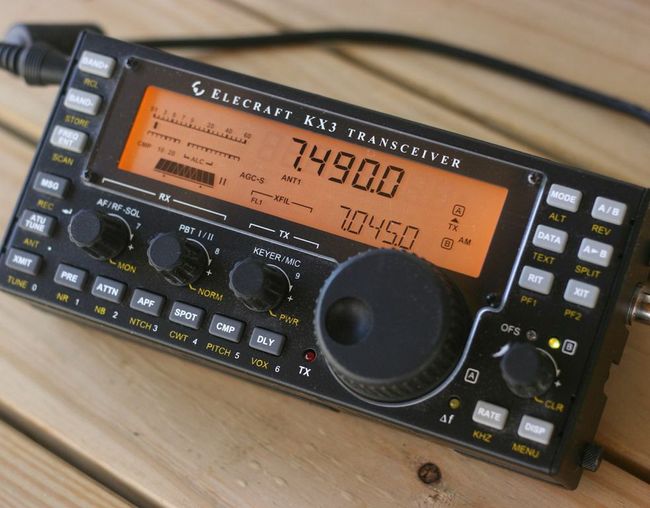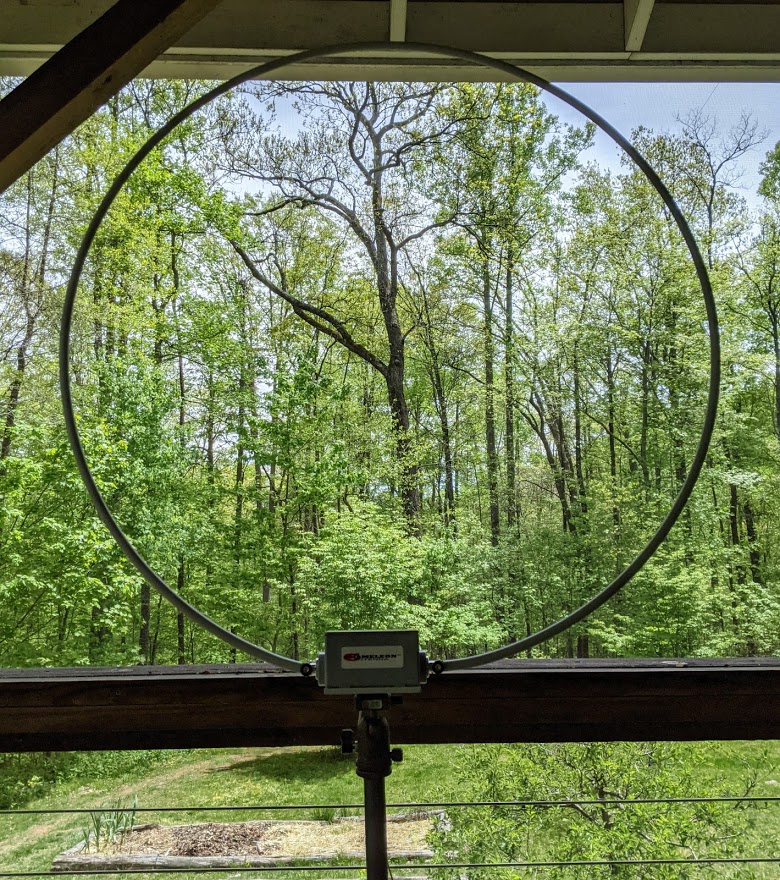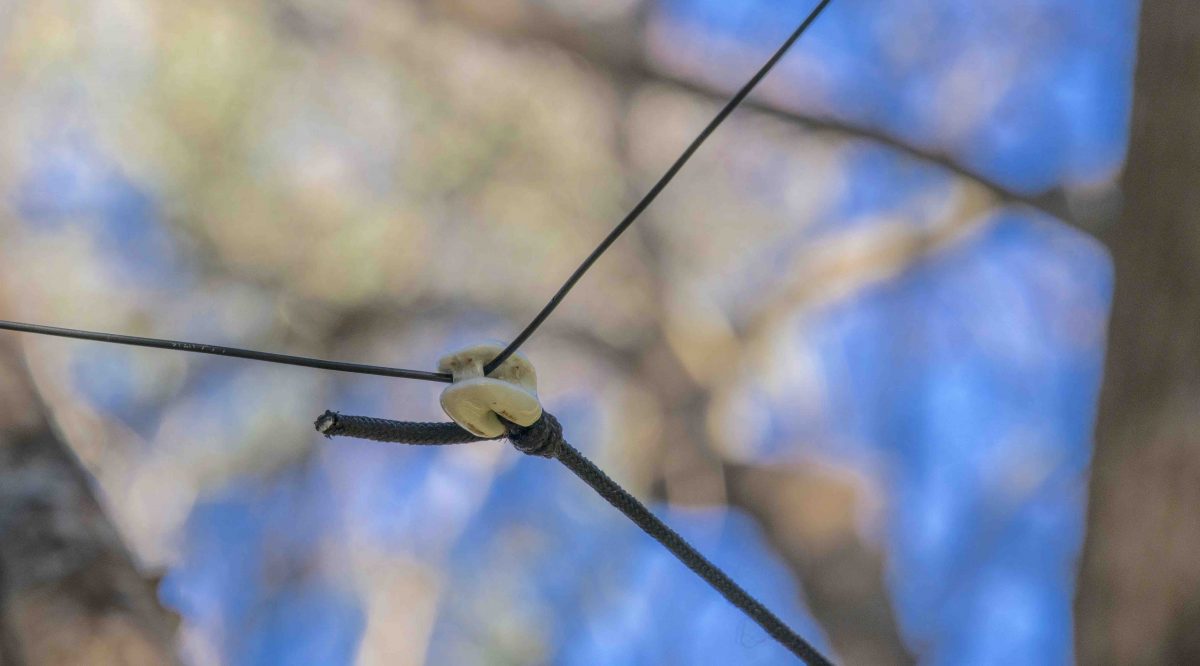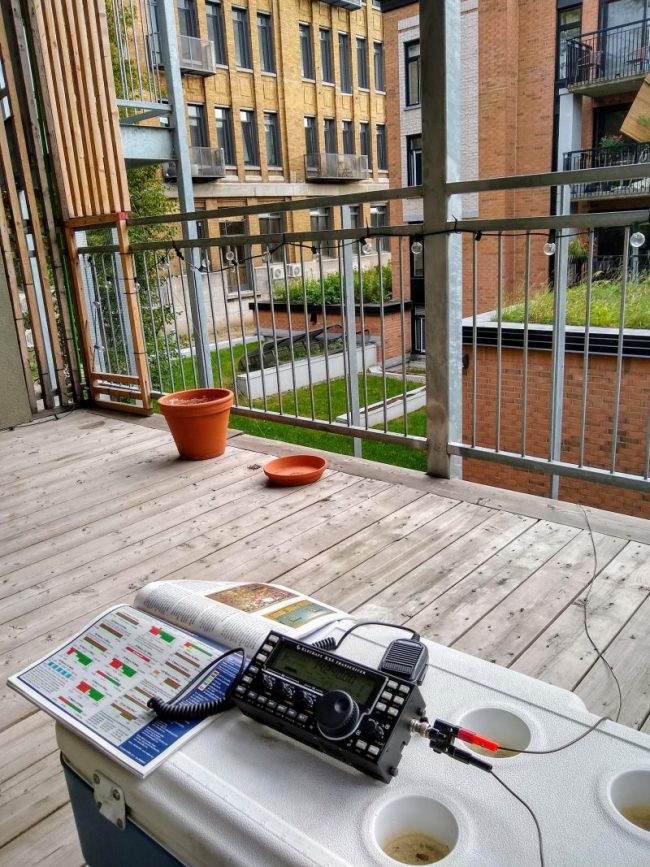 In the past few weeks, I’ve gotten a lot of questions from readers who are trying to decide if they should install a magnetic loop antenna or a simple wire antenna at their home. Obviously, most of the questions come from shortwave radio listeners, but some have come from ham radio operators as well.
In the past few weeks, I’ve gotten a lot of questions from readers who are trying to decide if they should install a magnetic loop antenna or a simple wire antenna at their home. Obviously, most of the questions come from shortwave radio listeners, but some have come from ham radio operators as well.
I realize that there’s a common theme to my answers and I thought it might be useful to share it here on the SWLing Post for future reference. I started to write a slightly more comprehensive article about this, but I quickly realized I want to keep my advice as short and clear as possible. I’ll be painting in broad brush strokes, but here you go:
If you live in an environment with a lot of radio interference…
Magnetic loop antennas are your friend.
By design, mag loop antennas are some of the best antennas for mitigating the radio frequency interference (RFI) that plagues so many of our homes and neighborhoods. When oriented vertically, mag loop antennas can also be rotated to null out unwanted signals on lower frequencies.
Mag loops come in a wide variety of configurations:
- The most popular among SWLs are wideband amplified loop antennas manufactured by companies like Wellbrook, Chameleon Antenna, MFJ, DX Engineering, Cross Country Wireless, Bonito, and a number of manufacturers in China. Unlike passive loop antennas, wideband amplified antennas require no manual tuning. These loops do require a power source, typically fed through a Bias-T or batteries.
- Passive loop antennas are popular among ham radio operators because they’re easy to build and, unlike amplified loop antennas, one can transmit into them if designed correctly. They’re less popular among radio listeners only because they typically have a very narrow bandwidth and need to be re-tuned (via a variable capacitor) each time you move frequency even a few kilohertz. The NCPL (Noise-Cancelling Passive Loop) which is also known as the Moebius or YouLoop is a bit of an exception and doesn’t require tuning, but does require a receiver with a very high dynamic range.
Loop antennas can also be very stealthy. In fact, Loop on Ground (LoG) antennas are essentially invisible and could be deployed (under the cover of darkness, of course!) in the most restrictive of neighborhoods. Note that since LoGs are horizontal, they are essentially omni-directional. [13dka corrects this in the comments: “This is somewhat ambiguous and not entirely correct: LoGs are horizontally oriented but (somewhat surprisingly) vertically polarized, and even more surprisingly they have the trademark property of verticals”]
We’ve also featured other stealthy loop designs like this porch loop.
As with any antenna, mag loops prefer to be outdoors but can be effectively used indoors if that’s the only option.
If you live in an environment free of radio interference…
Outdoor wire antennas are very hard to beat.
I am a case in point, in fact: I live in a rural, remote location without any meaningful RFI. All of my external antennas are homebrew wire antennas and they serve me incredibly well.
If you’ve been a reader for long, you may note that I don’t personally review amplified magnetic loop antennas often–these are typically published by some of our amazing contributors. This is because I like to do “apples to apples” comparisons and usually don’t have a second compact magnetic loop antenna for comparison here at SWLing Post HQ.
Almost without exception, my cheap homebrew wire antennas outperform wideband amplified mag loop antennas…sometimes, by orders of magnitude.
Many years ago, I tested a Pixel Loop amplified mag loop antenna (now under a different name and sold by DX Engineering) specifically for use on the mediumwave band to null unwanted stations. It was a very capable amplified mag loop antenna, but other than its MW nulling abilities, all of my homebrew wire antennas outperformed it on the HF bands. Reception was, at times, dramatically better on my wire antennas.
Of course, for a wire antenna to perform properly, it needs to be deployed properly. There are excellent resources out there that describe ideal heights and configurations for any given wire antenna design.
Keep in mind that wire antennas can be incredibly stealthy as well. It’s very difficult to see a wire antenna among or in front of a patch of trees, for example. At a previous home, I deployed a horizontal delta loop antenna on my property that–if you knew where to look–was easy to spot from the road. In all of the years we lived there not one neighbor took note, though, because the antenna wire had sky blue jacketing and I deployed it while no one was looking.
Summary
This isn’t an either/or choice for most of us. There’s no harm in building a simple wire antenna and trying it at home first. If the local noise floor is high, then consider adding a magnetic loop antenna to your arsenal as well.
You might find that the wire antenna has an advantage on frequencies where you have less radio interference, and the mag loop serves you well in those portions of the band with thicker RFI and QRM.
Find the best antenna system that works for you at home, but always remember that hitting the field with your radio has advantages as well!
What did I miss?
I omitted numerous antenna designs that aren’t straight-forward loop or simple wires. Check out some designs by our contributors Grayhat, Giuseppe Morlè (IZ0GZW), TomL, and many others here on the SWLing Post. As always, please feel free to comment!




Oh thank you for the information. Where do you mount a ham radio antenna on a car?
I live in an apartment, and have used a W6LVP active loop with great success for receiving, and also use a stealthily hidden dipole and a homebrew mag loop for transmitting. For SWL and HF monitoring, the LVP loop beats everything else, hands down in my situation. The W6LVP loop is mounted to my apartment balcony, and I managed to hide the dipole (55 feet, center fed with window line) along the exterior wall. The home brewed mag loop is a recent build and currently inside, but when outside, it picks up less noise than the dipole, but a bit more than the W6LVP receive only loop.
For receive only applications, the W6LVP active wideband loop is fantastic at reducing noise, and works far better than my wire antenna. For transmitting, I use the optional T/R switch so I can still use the active loop for receiving and use my other antennas for transmitting. Larry Plummer, W6LVP himself, does great work, and his customer service is excellent. He recently repaired a faulty T/R switch, and built a new loop amp for me with a built in notch filter due to my proximity to a 50 kw AM station. I highly recommend his products.
,
Thanks Bill,
Outstanding as the W6LVP is the first WALA I stumbled onto today in my web search. Good to know it works. I’ve been using long wires for several years in my backyard making steady progress on learning shortwave using the Tecsun PL-660 and 50 foot long wire. A project for this winter is trying out the W6LVP.
I think you will enjoy it. Just be aware you will need to find an adapter of some sort to connect your coax to the earphone-style jack the Tecsun uses.
Since we are at wire antennas, the same one which publicized the LoG, Matt Roberts (KK5JY) seems to be on something again, at least judging from his latest experiment
https://www.kk5jy.net/lla/
the LLA (Ladder Line Antenna) seems promising, and if one has some room to deploy one of these, it may be an interesting experiment
Now a note for 13dka, your favourite listening spot is near saltwater if I’m right, in such a case I believe that a double T-bar antenna may be worth a try
https://forums.qrz.com/index.php?threads/20m-vertical-dipole-vs-20m-1-4-wave-when-is-a-1-4w-better-if-ever.590790/page-3
🙂
VHF/UHF antennas and masthead amplifiers which can be observed from outside of the USA seem to have a poor selection.
In Australia virtually every dwelling has a TV antenna except remote areas which have the Viewer Accessed Satellite Television system which is free to air, but encrypted.
https://www.kingray.net.au/au/activity/kingray-domestic/ just remember that the VHF band in Australia is channels 6 – 12 which is 174 – 230 MHz = EU channels 5- 12, which is includes a USA amateur radio band, UHF is from channels 28 – 51, which is 526 – 694 MHz
Antennas
https://www.matchmaster.com.au/category/digital-tv-antennas/
https://bitek.com.au/products/antennas/
What does this have to do with loops vs. wire antennas on HF (or MW)? Mike
For other MW designs, check out this article from the RadioReference wiki…this includes the Ferrite Sleeve antennas (FSL)
https://wiki.radioreference.com/index.php/MW_DXing_and_Broadcasting#Antennas
And for more broadbanded designs, both active and passive types
https://wiki.radioreference.com/index.php/Loops
Mike
Getting back to the Loop on the Ground (LoG) antenna, there is a very extensive – and somewhat technical – discussion on the RadioReference website, viz.
https://forums.radioreference.com/threads/160-20m-log-loop-on-ground.370110/
And there’s even a Facebook group for it…
https://www.facebook.com/groups/319198328872015/
If you wish to try this antenna, reading these resources is highly recommended….Mike
If one has the space, a full one wavelength loop has enough bandwidth to cover one whole ham band plus every harmonic if considering transmitting. Receiving is more forgiving and I am a fan of the largest outdoor loop you can build using wire and a choke/balun. Amplification in a noisy environment just amplifies the noise. In fact, I now have two 32-foot magnetwire loops fed into a phaser unit which makes the strongest signals tolerable to listen to.
Indeed, low noise environments are great for longwire, end-fed, or dipole wire antennas. Some people love to put up full wavelength delta loop antenna between the tallest trees. Depends on situation at hand.
I forgot to add that porch mounted VHF antennas are much easier to create and lends itself better to an antenna mounted amplifier because to noise level is somewhat lower on VHF compared to SW/MW. I have the porch mounted VHF/UHF amp connected to a small FM dipole + small TV antenna and works very well for its size. The AirSpy YouLoop can be configured also as a VHF antenna, although it would need waterproofing using putty or spray-on liquid tape. Good for experimenting.
I use a Tecsun PL-660 in my backyard with a 50 foot Princeton Skywave heavy copper wire antenna in a California suburban neighborhood. I generally get good results…but there is some interference. Would a wideband amplified loop antenna work with a small portable like the PL-660? You’ve got me definitely considering it with this excellent article.
Maybe, depends on what the interference is. As you have a portable, you may be able to sleuth out the source. Obvious question – are you using a wall wart? That is very often the cause of much headaches due to their cheap construction.
I *think* there was such a problem with the PL880s at one time – it wouldn’t at all surprise me if the 660 had the same issue. Run off batteries and see if the interference goes away. If it does, you have your answer
Mike
Thanks Mike,
I run exclusively off (good) rechargeable batteries charged either with “intelligent charging function” or a Powerfilm solar charger.
My concept was always to be ready for mobile shortwave. I’m not the worlds best radio guy and I liked the simplicity of the long wire, which I can set up in about 15-20 minutes.. Does the WALA lend itself to mobile shortwave? Based on some of the photos here, it appears it does.
I have a PL-660 and tried it with my loop-on-ground amplified antenna, works very well. I think it only overloaded once on a strong SW signal but the 3-step DX switch took out that problem easily. Sensitive enough that I did not have to use Sync all the time like I have to with the whip. Worked well also with SSB on ham bands. It was satisfying.
I am sold on the loop-on-ground idea (just throw the wire on the grass/dirt in a flat circle). A vertical loop would help with directionality up to about 10-12 MHz, especially since you do not know where your interference is coming from (might even be your own house, or maybe a neighbor’s DSL router nearby). Interference is a whole ‘nuther topic!
Let’s not overlook the excellent series of loop antennas sold by Paul Karlstrand of PK’s Loops from Australia. I’ve owned a few models that Paul produces and they have all been excellent, and built very, very solid.
He offers a few models typically on Ebay USA, but I recommend buying directly through his catalog: http://www.amradioantennas.com/catalogue.htm. His web site’s main page is http://www.amradioantennas.com/index.htm.
My favorite for shortwave reception is the “Ham Loop for 3.5 – 14.5 MHz” http://www.amradioantennas.com/Leaflets/PK's%20HD%20Series%20HamLoop%20C-LOOP-HDSW3.5-14.5MHz.pdf
For medium wave, the crème de la crème of Paul’s designs is the C-LOOP-HDXLSM525-1725KHz http://www.amradioantennas.com/Leaflets/PK's%20HD%20Medium%20Wave%20Loop%20C-LOOP-HDXLSM525-1725KHz.pdf
In summary, PK’s Loops are top performers for the MW and SW hobbyist.
Sorry for the smart-assing but…
“Note that since LoGs are horizontal, they are essentially omni-directional. ”
This is somewhat ambiguous and not entirely correct: LoGs are horizontally oriented but (somewhat surprisingly) vertically polarized, and even more surprisingly they have the trademark property of verticals: A low elevation angle, depending on the ground. Speaking of which, according to KK5JY they are bidirectional at low elevation angles and become unidirectional at high elevation angles. Both of these traits can make them surprisingly good DX antennas.
Unfortunately I still didn’t manage to buy an antenna switch so I couldn’t make a video demonstrating this in practice yet (and I’m curious to see that in direct A/B-ing myself) but every time I throw one of my LoGs on the grass behind the dike, I’m surprised how they have the same pronounced preference for transatlantic (and beyond) signals.
I should add that (again, according to K5JY) LoGs may even beat regular verticals over less-than-ideal ground in picking up low-angle (=DX) signals. That being said, I have to admit that loops are quite counter-intuitive and confusing. Small loops vs. big loops and how they act differently, how loop size, orientation in space *and* feedpoint position decides about polarization and radiation pane…
“Find the best antenna system that works for you at home, but always remember that hitting the field with your radio has advantages as well!”
Absolutely! Hitting the field and finding an antenna system that works best there in the field, for that particular type of field is a recipe for radio bliss.
I stand corrected! 🙂 Thanks for that!
Oh, I updated the post with your “smart-ass” comment, 13dka! 🙂 Thanks for the correction–seriously. I made an incorrect assumption about polarization, but honestly it makes sense. The loop is couple to the ground, so I see where that polarization switch could happen.
Tom, I like the way you approached this topic. I see so many posts that say this or that & and there is no room for disagreement. What every ham & SWL should know is there are very few absolutes. What works at one QTH may not at another. And the biggest variable at a QTH is the operator. If someone tells you it won’t work, try it anyway. This is especially true for antenna systems. Long ago Cebik said if the physics are not working for you, then try something else.
-Bob
I prefer my dipoles; both are Chameleon ENCOMM II 60’ length: 2nd story shack above shared driveway 20’ at feed point — sloper — is my permanent… Other is my experimental off back porch into yard; 18-20’ high. Especially like portable one. Lots of options, including POTA Operation. Both are affordable & FUN!
73 Jeffrey K8SNR ???
Both is a good option for hams with QRM. W6LVP sells the loop with a T/R switch option. You can string the wire up in an optimal transmitting setup without having to worry or compromise position because of what normally would induce noise into the wire, then just mount the loop somewhere cleaner and rotate for lowest noise.
Good post . . . very helpful.
This may work for some people as well: https://swling.com/blog/2021/06/jock-designs-a-horizontal-room-loop-to-cope-with-reception-issues/
Keep up the good work!
I’m a recent ‘convert’ to mag loops. They may not be perfect, but they are far and away the best antenna for most users IMHO. I don’t want to hear about SWL wire antennas ever again. LOL
‘Specialized’ listening is another story though.
My next experiments will be to use them on transmit. I see condo living in my near future, so better prepare.
On recent 10 meter activity, I used a full wavelength vertically oriented magnetwire loop (balun connected at bottom center making it horizontally polarized) and was reaching 1000 mile contacts. I am going to try two folded half wavelength loops (cross connected at the center mounted balun) and see if that will work for 40 meters. If you have to get a condo, try to get one with a large outdoor porch made of wood.
Tom, here’s an idea for you, build the loop with the two vertical arms linearly loaded, such a config will make them electrically longer, I simulated such a config in 4NEC2 and it gave interesting results, but I never went on building the real thing, so if you want to experiment, such a config may be interesting 😉
Thanks, I will consider it! Been trying to figure a way to maximize the vertical portion to do most of the transmit radiating. I stumbled on this design of a folded C-shaped loop, have no idea if it works – http://www.aresraces-leecountyfl.org/assets/folded_loop_antenna.pdf
Tom, the idea is shown in this image
https://forums.qrz.com/index.php?attachments/upload_2017-9-22_10-44-51-png.402024/
basically, by linearly load the two vertical arms, the antenna becomes (electrically) a rectangle, and this changes its radiation pattern
oh and Tom, here’s something worth reading
https://www.qsl.net/dk7zb/DK7ZB-Quad/Oblong.htm
I believe that combining the vertical side loading with the above notes it may be possible to obtain a compact yet pretty good performer